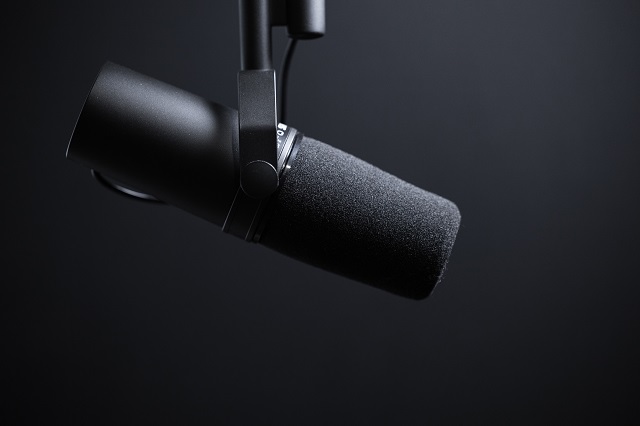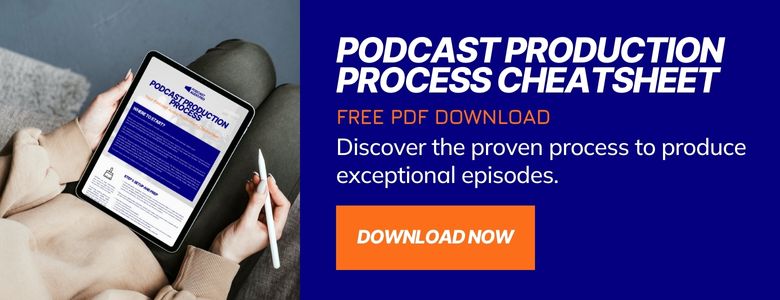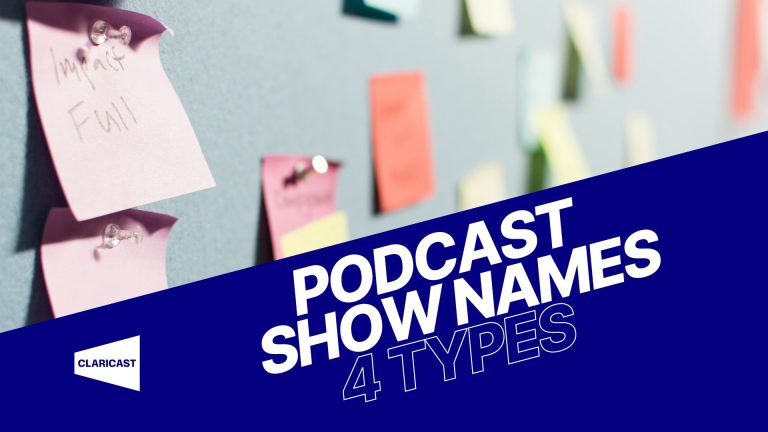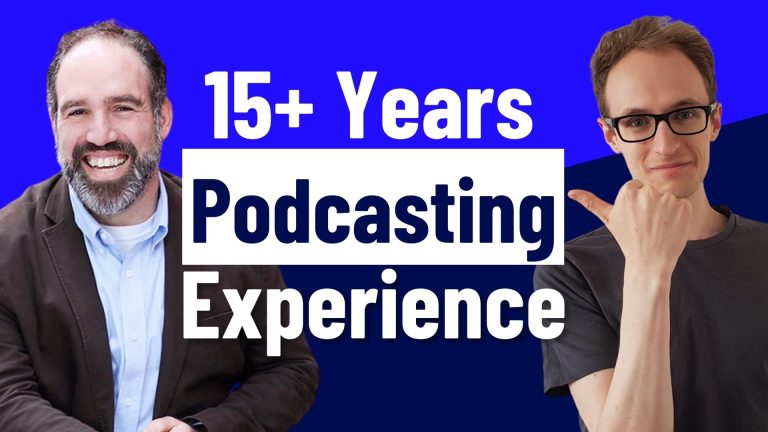The quality of your audio plays a huge role in the growth of your podcast. There are too many podcasts out there now, sharing your space, for you to settle for low-quality, unbalanced, echoey audio. Many listeners will simply look elsewhere.
In this article, I’m going to go through my top 25 podcast audio tips for recording, production and workflow. These are easy things that you can do to help you achieve a studio-quality sound.
Click here to watch this article on YouTube instead.
Let’s get started with 12 podcast audio tips focused on getting you started off with the best recording possible.
Some of these links are affiliate links – we get a small portion of the sales through these links.
Recording Tips
1. Invest in a Good Microphone
Starting out with a solid recording makes it much easier for you or your editor to get the best result. And your mic choice is the most impactful decision you’ll make for your podcast audio.
But it doesn’t have to cost the world. A dynamic microphone like the Audio-Technica ATR2100x at around £80/$80 or the Shure MV7 at around £200-£250 if you have a bit more to spend will capture a high-quality, intimate-sounding recording.

Avoid condenser microphones like the Blue Yeti if you’re not recording in a professional studio.
2. Use a Pop Filter
Also known as a windshield. These are foam balls or mesh screens that go in between your mouth and the mic. It stops the mic from picking up windy ‘P’ and ‘B’ sounds – also known as ‘plosives’.
If your mic already has a thick foam cover, you can probably just rely on that. If it just has a metal mesh, you’ll need that extra protection.

3. Choose the Right Room
Record in a quiet room with minimal background noise. Even though the dynamic mics I mentioned will help avoid picking up too much background noise. It’s still best to record in as quiet a place as possible.
A room with soft furnishings and carpeted floors can also help absorb the echo or reverb to get you that intimate sound.
4. Proper Mic Placement
This is a commonly missed one. Your mic should be pointing directly at your mouth, with around a 4-6 inches gap between your mouth and the mic. Too far away and the room sound will be picked up more. Too close and your mic might pick up too much bass and it’ll be easier to knock your mic.
If you’re using a little desk stand that came with your mic and makes it difficult to position the mic correctly, consider buying a boom arm that connects to your desk.
5. Monitor Your Levels
Your mic or your recording software should have a meter that shows how loud your audio input is. Your audio shouldn’t be hitting the red, or the top of the meter. Otherwise, it’ll cause nasty distortion, called clipping.
Adjust your mic level on your mic or software, so that the level when you’re speaking normally is hovering around the middle.
6. Use Headphones
This is especially important for interview podcasts. If you or your guest aren’t wearing headphones, the sound from your speakers will be picked up by the microphone, leading to a horrible doubling effect called ‘bleed’.

So wear your headphones or earbuds. If you’re recording locally with a co-host, you still may want to wear headphones to monitor your recording live.
7. Use The Right Recording Software
If you’re recording locally onto your computer, any good audio software, or digital audio workstation (e.g. Reaper, Audacity, Adobe Audition) will do the job.
If you’re recording interviews online, avoid basic, free calling software like Google Meet or Teams. They don’t let you record speakers to separate tracks, and they butcher your audio quality.
If you get the settings right, Zoom can get you a good result. Better yet, a locally-recording, online calling tool like Riverside, will record your online calls without your network connection affecting the quality.
8. Record in WAV or AIFF Format
If your software allows you to choose the file format you save or download your recordings as, choose .WAV or .AIFF. These are uncompressed files, meaning you’ll be getting the full quality.
As an example, Riverside allows you to download your files in .WAV or .MP3 format. MP3 is a compressed/reduced-quality file format. And even though your episode will be exported as an MP3 file at the end, you’re best off sticking with the full-quality files until the last minute, to avoid over-processing.
9. Keep Still
I’ve mentioned your positioning with the mic. Well, try to keep it that way throughout your episode recording. That’s not to say you should be completely motionless like a statue. Just try to keep within that 4-6 inches throughout to avoid wavering audio levels.
10. Non-Verbal Active Listening
This one will make the job of editing much easier. Rather than saying ‘mm’ and ‘yeah’ throughout your guest’s response, stick to facial expressions and nodding. You’ll notice that professional interviewers on TV do this.
You’re naturally going to verbally respond on occasion, and that’s fine, just aim to keep it to a minimum. It will save editing time and help both the speaker and your listeners concentrate on what they’re saying.
11. Warm Up
If you haven’t spoken to anyone all day and you jump straight into a podcast recording, you might find it difficult to get into the conversation. And your voice might not be sounding at it’s best. Both from a physical and mental perspective. Your voice needs warming up and so does your mind.
I’ve done a lot of recording for singers, and I would always have to take a few recordings, and would never use the first take. It works similarly for dialogue recording.
Before hitting record, having a 5 to 10-minute chat with your guest or co-host should be enough.
12. Stay Hydrated
Have a drink, ideally room-temperature water with you while you record. It sort of amazes me how many podcasters don’t do this!
I know I’ve edited episodes before where half-way through, the host will start clearing their throat and coughing more and more. And I’m thinking… it’s okay… pause for a minute… take care of yourself!
Post-Production Tips
If you have an editor/producer working on your show, these podcast audio tips will apply less to you – they should be doing all of this stuff. Feel free to skip the last section – mindset tips. If you’re post-producing your own show – read on!
13. Detailed Editing
Editing isn’t going to take away the authenticity of your podcast. Editing will ensure that your listener keeps listening. An unedited or barely edited podcast will push your new listeners away and towards other podcasts that deliver them the same value in less time.
Filler words, extraneous noises, extended periods of dead air, interruptions, mistakes, false starts, tangents that offer no value to the listener… all of it can go. This is an essential part of podcast production today.
14. Reduce Noise
This is a big one. Sometimes, you can’t avoid noisey recordings. Maybe your guest has a noisey mic.
Before you start editing, use a noise reduction tool to reduce as much noise as possible. iZotope RX has a fantastic noise reduction plugin. Or for a free option, Audacity’s noise reduction is pretty good, too.
15. Balancing Levels
Balancing the levels of your speakers is the quickest way to make your podcast episodes much more enjoyable and easy to listen to.
You can do this during recording if you’re recording locally, or during the mixing stage after recording. Simply adjust the volume of each of your tracks so they sound more or less the same level.
Levels will naturally waver throughout the episode, but your editing will take care of that, as well as compression, which I’ll cover shortly…
16. Equalisation
Equalisation or ‘EQ’ is the process of reducing or increasing the level of certain frequencies like the bassy lows or the trebly highs.
Most digital audio workstations like Reaper, Audacity, Adobe Audition and so on have EQ plugins built in. And most podcast vocal recordings will benefit from the sub-bass frequencies removed, the bass increased slightly and the low-mids reduced.
For a more in-depth look at using EQ, check out this video.
17. Compression
A compressor is a plugin that, again, you’ll find included in any good editing software. A compressor reduces the level of your audio, but only once if goes over a certain threshold. This means that the overall level of each speaker will be more balanced throughout.
Again, for a more in-depth look at using compression, check out this video.
18. Gates
A gate is sort of like the opposite of a compressor. It’s a tool that reduces the level of your audio once it goes below a certain threshold. This is great for easily reducing the levels of non-verbal sounds like background noise.
And you better believe we’ve got a video that goes into more detail!
19. De-Essing
The last audio plugin I’m going to mention is a de-esser. These reduce the level of high-frequency sounds, namely harsh ‘S’ sounds, whenever they get too loud.
Many digital audio workstations won’t have a de-esser built in. You can use EQ for a similar effect.
20. Loudness
The standard overall average loudness for a podcast episode is -16 LUFS integrated. Mastering your podcast episodes to this loudness will ensure that they sound great next to other episodes on the apps.
If your software doesn’t have a loudness meter built in, you can download a free plugin from Youlean.
21. Create a Template
If you’re editing multiple episodes of the same show, which is likely, save a template in your audio software to save you loads of time.
After editing and mixing your first episode, all of your plugin settings and common assets like the intro & outro should be in place. Save your session as a template to give you a head start on future episodes.
Workflow Tips
22. Backup Your Files
Backup all of your podcast files regularly. I recommend either using an online cloud service like Google Drive or Backblaze. If you’re using Riverside, once you’ve downloaded your recordings, you’ll have them saved in two places.
Consistency is key with podcasting. And recording episodes takes time. It’s not always that easy to re-record. Keeping backups will save you from having to rush out a poor-quality episode at the last minute.
23. Test Your Equipment Regularly
Check your microphone, headphones, and other equipment regularly to ensure they’re working properly. Especially if you haven’t recorded an episode in a while. Best take the time to check before-hand, rather than finding out at the start of the interview that something’s not working.
24. Get Feedback
Listen back to your episodes and have a think about which of these tips you could focus on to improve your episodes. Compare your podcast to others in your niche. Share podcast audio tips. Not that you should be where they are, just to give you a guide and some inspiration.

As you collect reviews and ask your listeners and other podcast producer’s opinions, you’ll have a better idea of what to focus on.
25. Practice
The great thing about podcasting is that you’ll be recording lots of episodes. This gives you plenty of chances to practice and improve. Don’t worry if your podcast doesn’t sound perfect in episode one. You can still grow a podcast even if it doesn’t and improve over time.
I hope these podcast audio tips will help you to improve your podcast and retain new listeners. Let me know which tip you’ll be focusing on first, or if you have any other great podcast audio tips to share.





